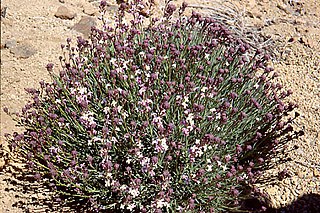
Erysimum, or wallflower, is a genus of flowering plants in the cabbage family, Brassicaceae. It includes more than 150 species, both popular garden plants and many wild forms. The genus Cheiranthus is sometimes included here in whole or in part. Erysimum has since the early 21st century been ascribed to a monogeneric cruciferous tribe, Erysimeae, characterised by sessile, stellate (star-shaped) and/or malpighiaceous (two-sided) trichomes, yellow to orange flowers and multiseeded siliques.

The Great Basin Desert is part of the Great Basin between the Sierra Nevada and the Wasatch Range. The desert is a geographical region that largely overlaps the Great Basin shrub steppe defined by the World Wildlife Fund, and the Central Basin and Range ecoregion defined by the U.S. Environmental Protection Agency and United States Geological Survey. It is a temperate desert with hot, dry summers and snowy winters. The desert spans large portions of Nevada and Utah, and extends into eastern California. The desert is one of the four biologically defined deserts in North America, in addition to the Mojave, Sonoran, and Chihuahuan Deserts.

The insects of the beetle family Chrysomelidae are commonly known as leaf beetles, and include over 37,000 species in more than 2,500 genera, making up one of the largest and most commonly encountered of all beetle families. Numerous subfamilies are recognized, but the precise taxonomy and systematics are likely to change with ongoing research.
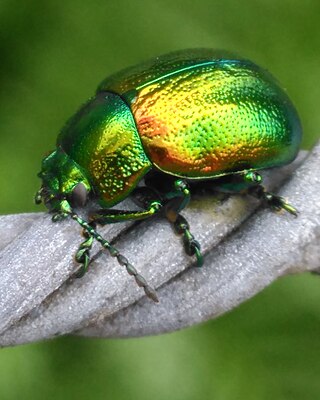
The Tansy beetle is a species of leaf beetle. The common name derives from its main foodplant, Tansy, but it can also use other wetland plants such as Gypsywort and Water Mint. It measures 7.7–10.5 mm in length and has a characteristic bright metallic green colouration, with pitted elytra and a coppery tinge. In addition to the nominotypical subspecies, which repeats the specific name, C. graminis graminis, there are five further distinct subspecies of Tansy beetle, which, collectively, have a Palearctic distribution, although in the majority of countries where it is found the species is declining. In the United Kingdom it is designated as 'Nationally Rare'. The stronghold population here is located along the banks of the river Ouse in York, North Yorkshire. Other, small, fenland populations exist at Woodwalton Fen and at Welney Wildfowl and Wetlands Trust (WWT) reserve.
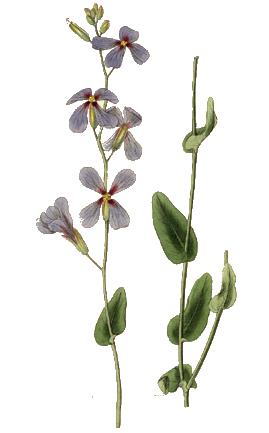
Moricandia is a genus of plants of the family Brassicaceae. This genus is mainly distributed in North Africa, the Middle East, and Southern Europe. It is associated with arid and semi-arid environments. Flowers of this genus are actinomorphic-dissymmetrical and mostly lilac in color, although they vary from white to purple depending on the species and climatic conditions. Some species show extreme phenotypic plasticity for flower size, shape, and color. The fruits are two-valved dehiscent siliques with one or two sets of seeds per valve.
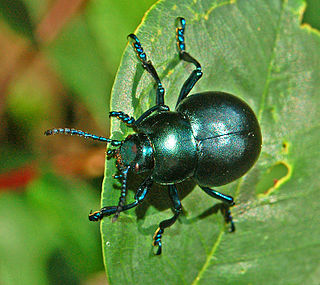
Timarcha is a genus of leaf beetles in the family Chrysomelidae, with more than 100 described species in three subgenera. The most widely known species is T. tenebricosa, the bloody-nosed beetle. All species are black, wingless organisms. Timarcha are herbivorous species, living mostly on plants belonging to Rubiaceae and Plumbaginaceae, although a few can feed on Brassicaceae and Rosaceae. Timarcha is the only member of the tribe Timarchini.

Sociality is the degree to which individuals in an animal population tend to associate in social groups (gregariousness) and form cooperative societies.

The Chrysomelinae are a subfamily of leaf beetles (Chrysomelidae), commonly known as broad-bodied leaf beetles or broad-shouldered leaf beetles. It includes some 3,000 species around the world.

The Sierra Nevada subalpine zone refers to a biotic zone below treeline in the Sierra Nevada mountain range of California, United States. This subalpine zone is positioned between the upper montane zone at its lower limit, and tree line at its upper limit.

Parasyrphus nigritarsis is a species of hoverfly, from the family Syrphidae, in the order Diptera. It is known from northern Europe and North America, and has been considered to be a rare species in parts of its range. Adults visit flowers as a source of nutrition, and females lay their eggs on clutches of eggs of leaf beetles. When the Parasyrphus larvae hatch, they first consume leaf beetle eggs and then consume immature beetles until they reach the pupal stage. This species is related to hoverflies that prey on aphids as larvae, and has been investigated in studies of chemical ecology and food web ecology.

Gnophos furvata is a species of moth in the family Geometridae. It is found in southern and central Europe. In the east, the range extends to the Carpathian Mountains and Ukraine.
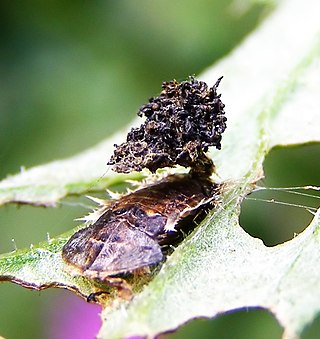
The fecal shield is a structure formed by the larvae of many species of beetles in the leaf beetle family, Chrysomelidae. It is composed of the frass of the insect and often its exuviae, or bits of shed exoskeleton. The beetle may carry the shield on its back or wield it upon its posterior end. The main function of the fecal shield is defense against predators. Other terms for the fecal shield noted in the literature include "larval clothing", "kotanhang", "faecal mask", "faecal pad", and "exuvio-faecal annex".

Phratora is a genus of leaf beetles. It is synonymous to Phyllodecta . European Phratora species can be distinguished based on morphology of female genitalia., but they differ little in size and body form and most show metallic coloration.
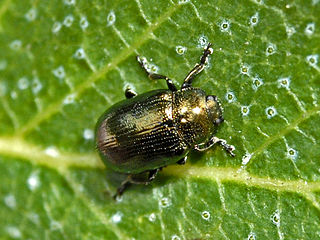
Phratora vitellinae, the brassy leaf beetle, formerly Phyllodecta vitellinae, is a beetle of the family Chrysomelidae found in Europe and Asia. It feeds on Populus and Salix species. The evolution of its host plant preferences and the mechanism by which it uses host plant chemicals to make a larval defensive secretion have been the subject of intense study by research groups in Europe and the Nordic countries.

Calligrapha pantherina, the sida leafbeetle, is a species of beetle in the family Chrysomelidae, endemic to Mexico. The larvae and adult beetles feed on the foliage of the common wireweed and the arrowleaf sida. This beetle has been introduced into Northern Australia as a biological control agent in an attempt to control its host plants, which are invasive weeds there.

Phratora laticollis is a species of leaf beetle found in Europe and Asia. This beetle is found on Populus species and the chemistry and production of its larval defensive secretions and host plant relationships have been studied extensively.

Chrysomela aeneicollis is a species of leaf beetle in the family Chrysomelidae. This organism has been used as a model for studies of natural selection in nature. It is currently being investigated to study effects of environmental change on insect populations, and the evolutionary significance of variation at genes affecting metabolism and the response to stress. It has been included as a study species in the California Conservation Genomics Project, due to its presence in multiple California ecoregions and extensive knowledge of genetic variation, evolutionary ecology, and interactions with other species. Information about its range and comparisons with closely related species can be found in a review of the genus Chrysomela published in the Canadian Entomologist.
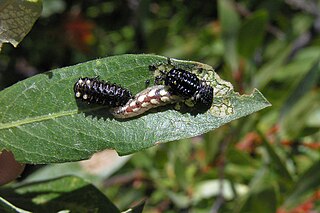
Parasyrphus melanderi is a flower fly that is best known as a larval predator on the leaf beetle Chrysomela aeneicollis in the Sierra Nevada range of California.

Symmorphus cristatus is a species of mason wasp in the subfamily Eumeninae within the family Vespidae. This species is widely distributed in North America, and it preys on the larvae of leaf beetles.

Phratora polaris is a species of leaf beetle found in the Nordic regions of Europe., occasionally in Scotland, and Iceland. Some authors have recorded it in central Europe, especially in the Alps. Historically, this species has occurred in Greenland. This beetle is found on willow (Salix) species in the southern part of its range. Populations in Lapland feed on birch.
González- Megías, A., J.M. Gómez & F. Sánchez-Piñero 2005. Consequences of spatial autocorrelation for the analysis of metapopulation ecology. Ecology 86:3264-3271.
González- Megías, A., J.M. Gómez & F. Sánchez-Piñero 2005. Regional dynamics of a patchily distributed herbivore along an altitudinal gradient. Ecological Entomology 30: 1–8.
González-Megias, A., Gómez, J.M. & Sánchez-Piñero, F. 2004. Ecology of the high mountain chrysomelid Timarcha lugens Rosenhauer (Chrysomelidae). In: Jolivet, P.; Santiago-Blay, J.A. & Schmitt, M. (eds.) New developments in the biology of Chrysomelidae, págs. 553–563. SPB Academic Publishing, La Haya, The Netherland.
González-Megias, A. & Gómez, J.M. 2003. Consequences of removing a keystone herbivore for the abundance and diversity of arthropods associated with a cruciferous shrub. Ecological Entomology 28:299-308.
Gómez, J.M. & González-Megías, A. 2002. Asymmetrical interactions between ungulates and phytophagous insects: being different matters. Ecology 83:203-211.
González-Megías, A. & Gómez, J.M. 2001. Adult and larval plant range and preference in Timarcha lugens (Coleoptera: Chrysomelidae): strict monophagy on an atypical host. Annals of the Entomological Society of America 94:110-115.





















